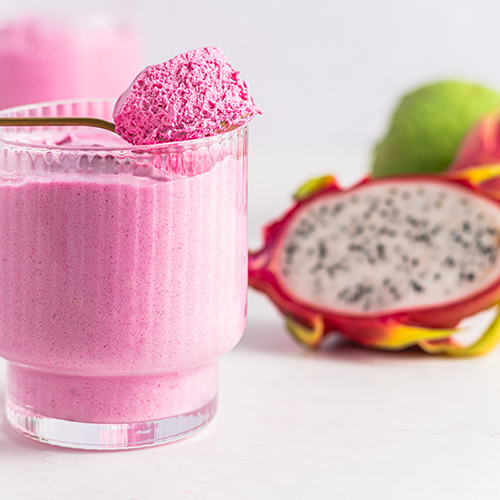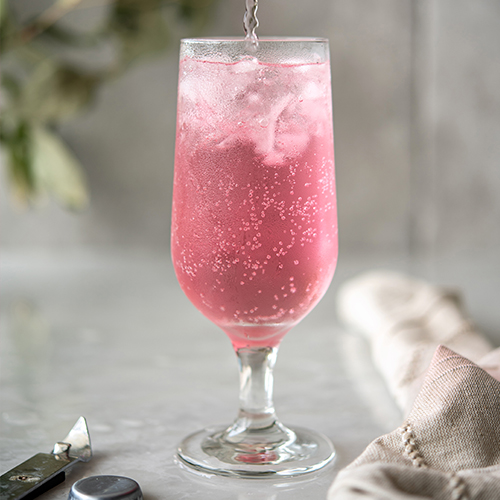How pop culture is powering pink food and drink
Since 2023’s Barbie film swept across cinema screens worldwide, the world has been thinking pink. The power of pop culture to shape trends across entire market segments has never been more evident – and food and drink is no exception. Manufacturers are surfing the Barbie-pink wave to launch pretty-in-pink products with the power to become immediate, Instagram-worthy sensations.
The Barbiefication of food and drink
With customer research finding that pink engenders feelings of love, joy, and pleasure [1], brands are using it to trigger positive emotional responses that make foods and drinks more exciting and appealing.
Pink is strongly associated with sweetness [2], with research showing that a pink drink is perceived to be sweeter and tastier than an uncolored but otherwise identical one [3]. Brands are leveraging this by coloring shakes, sodas, and desserts such as ice cream and cakes in a rainbow of pink shades to accentuate their sweet appeal.
The Barbiefication effect has also moved into less immediately associated categories, including savory offerings. Here, recent launches are playing with color expectations by using bubble-gum pink hues, including:
- Barbie-branded mayo barbecue sauce
- Pizza with a pink base and pink dressing
- Barbie-themed burger
Yet, with the pink aesthetic recognized even without the official Barbie logo, this trend is no longer just about Barbie. Many different ways are emerging of using pink to add appeal to products, and these stem in part from how perceptions of pink have evolved over time.
A colorful history
As a close relative of fiery red, pink was historically seen as a masculine color suitable for boys, with blue considered a daintier, prettier hue more appropriate for girls. The stereotype of ‘pink for girls’ and ‘blue for boys’ only arose in 19th century France and later spread into the US as a canny marketing strategy [4].
The ‘pinkification’ of global female culture really took off in 1950s America, where it was part of a behavioral ‘nudge’ to reinforce gender roles in the post-war era.4 In 1959, when Barbie made her fashion-doll debut, she was regarded primarily as a symbol of glamor and style.
However, it wasn’t until the 1970s that her packaging became predominantly pink and the color started to become associated with empowerment. By the end of that decade, punks were claiming pink as a symbol of rebellion. Fast-forward into the 21st century, and pink was being embraced by R&B artists like Rihanna, while films like ‘Legally Blonde’ subverted the idea of pink as sweet and submissive.
Swiftie pink: a new era
In the 2020s, pop culture is positioning pink as symbolic of a new age of femininity that is much more inclusive and radical.
Take the world’s biggest pop star, Taylor Swift, and her devoted fan base of ‘Swifties’, who not only adore her music but also celebrate her signature color: pink. Her lyrics often evoke pink’s associated emotions of love and vulnerability but also resilience, empowerment, and fun – reflecting consumers’ desire for products that bring joy to their lives.
Bring the pink trend to life
While Barbie launches appeal to a specific demographic, manufacturers are playing into the pink trend with products that push the boundaries of aesthetic norms and provoke interest in a wider audience.
A pink cupcake provides a straightforward way to tap into the trend, but a pink plant-based dragon fruit mousse or bright pink grapefruit soda can benefit from pink’s wider popularity to evoke a sense of fun while also appealing to a more health-conscious target audience.
Recent successful launches taking this approach include luxurious ruby and pink shades for confectionery bars and ice cream that go beyond playful, sensorial satisfaction to create a sense of sophistication, empowered pleasure, inclusive femininity, and authenticity.
It’s all about a deep understanding of the category, product positioning and creating the right shade.
Think pink
At GNT, we work closely with customers to define product identity and meaning through color, ensuring they are sending the right messages to their target consumers.
We offer a range of EXBERRY® plant-based pinks from raw materials such as beetroot, carrot, sweet potato, and radish that deliver a vibrant palette of pink shades in many different food and drink applications.
With the influence of pop culture never stronger, we can help you embrace the true power of pink.
You might also enjoy these related reads:
- Why wellness is big in beverages
- New 2024 trends shaping the future of beverages
- Our trend campaign: Regeneration Rising
[1] Johannes Gutenberg University, ‘Colors evoke similar feelings around the world’ (2020)
[2] Spence, C. et al., ‘On tasty colours and colourful tastes: assessing, explaining, and utilizing crossmodal correspondences between colours and basic tastes’, Flavour (2015)
[3] Brown, D.R. et al., ‘Mouth rinsing with a pink non-caloric, artificially-sweetened solution improves self-paced running performance and feelings of pleasure in habitually active individuals’, Frontiers in Nutrition (2021)
[4] Sotheby’s, ‘A cultural history of pink – just in time for the pinkest summer ever’ (2023)



